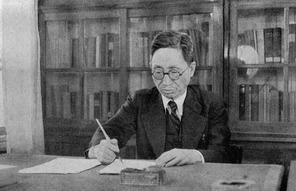Ri Ki-yong facts for kids
Quick facts for kids
Ri Ki-yong
|
|
|---|---|
 |
|
| Born | May 29, 1895 Asan, South Chungcheong |
| Died | August 9, 1984 (aged 89) Pyongyang |
| Language | Korean |
| Nationality | North Korean |
| Korean name | |
| Chosŏn'gŭl | |
| Hancha | |
| Revised Romanization | I Giyeong |
| McCune–Reischauer | Ri Kiyŏng |
Ri Ki-yong (also known as Lee Gi-yeong) was an important Korean novelist. He was born on May 29, 1895, and passed away on August 9, 1984. He wrote many stories about the lives of ordinary people.
Contents
Life of Ri Ki-yong
Ri Ki-yong was born in Asan, a place in Korea. He sometimes used the pen name Minchon when he wrote. He studied English in Tokyo, Japan.
In 1925, Ri Ki-yong became part of a group called KAPF. This group was for writers who believed in "proletarian literature." This type of literature focused on the lives and struggles of working-class people. He helped start the Choson Proletarian Writers' Federation in Seoul. He also led the North Choson Federation of Literature and Arts.
In 1926, he worked as an editor for a magazine called Light of Joseon. This magazine supported the Korean Communist Party and shared ideas about literature for the working class. Ri Ki-yong spent more than two years in prison during this time.
After Korea became free from Japanese rule, Ri Ki-yong moved to North Korea. There, he played a big part in shaping how literature was written and understood. He held an important position in the North Korean Federation of Literature and Arts for many years. He is believed to have died in August 1984.
Ri Ki-yong's Literary Works
Ri Ki-yong was a leading writer in the "proletarian literature" movement. He wrote about the difficult lives of farmers. These farmers were often treated unfairly by landlords and faced hardships under colonial rule.
His stories like Flood (Hongsu) and Rat Fire (Seohwa) are good examples of "peasant literature." They show the tough reality of life in the countryside from the viewpoint of the working class. Seohwa especially looked closely at how farmers were both part of the working class and also owned some property.
Ri Ki-yong believed that farmers were not all the same group. He thought that very poor farmers, who had experienced unfair treatment, could be good partners with the working class in their struggles for a better life.
His most famous novel, Hometown (Gohyang), showed these ideas clearly. It was first published in parts in The Chosun Ilbo newspaper. Like other famous novels of that time, Hometown tells the story of educated people who go back to their villages. They try to help and teach the farmers who are struggling.
Even though Ri Ki-yong was a famous writer, he is not very well known in his home country today. Information about writers' lives is often not shared widely with the public there.
Notable Books by Ri Ki-yong
Here are some of Ri Ki-yong's well-known works:
- Seohwa〈서화〉
- Ingan suop〈인간수업〉
- Kohyang 〈고향〉 (Home village), published in 1934
- Shin gaeji〈신개지〉 (Newly ploughed land), published in parts
- Ddang〈땅〉 (Soil), published in 1949
- Tuman gang〈두만강〉 (Tumen River)
- Bom〈봄〉 (Springtime), published in parts in The Dong-A Ilbo in 1940
Works Translated into German
- Heimat (which is Gohyang or Hometown)
See also
 In Spanish: Ri Ki-yong para niños
In Spanish: Ri Ki-yong para niños

